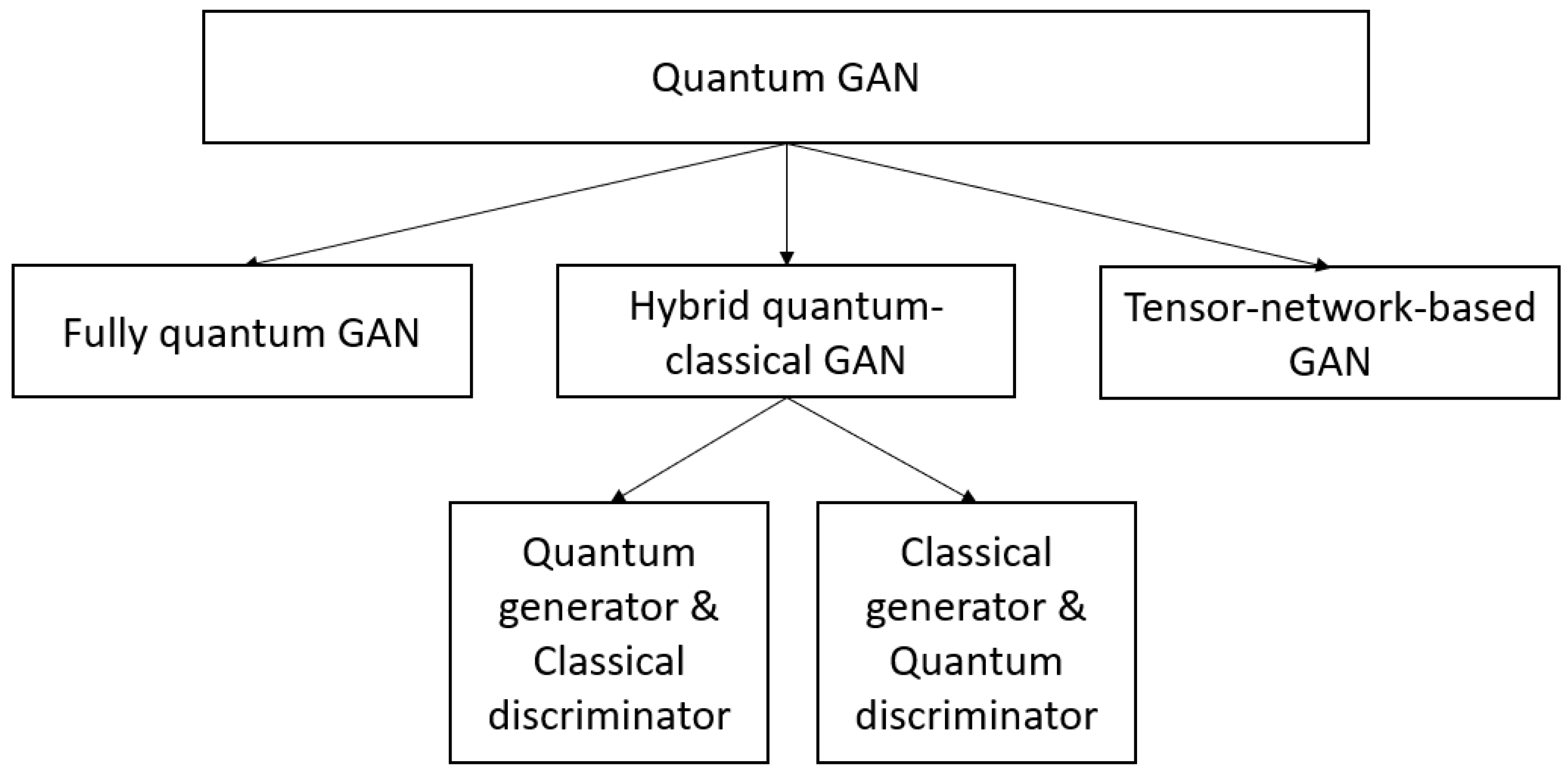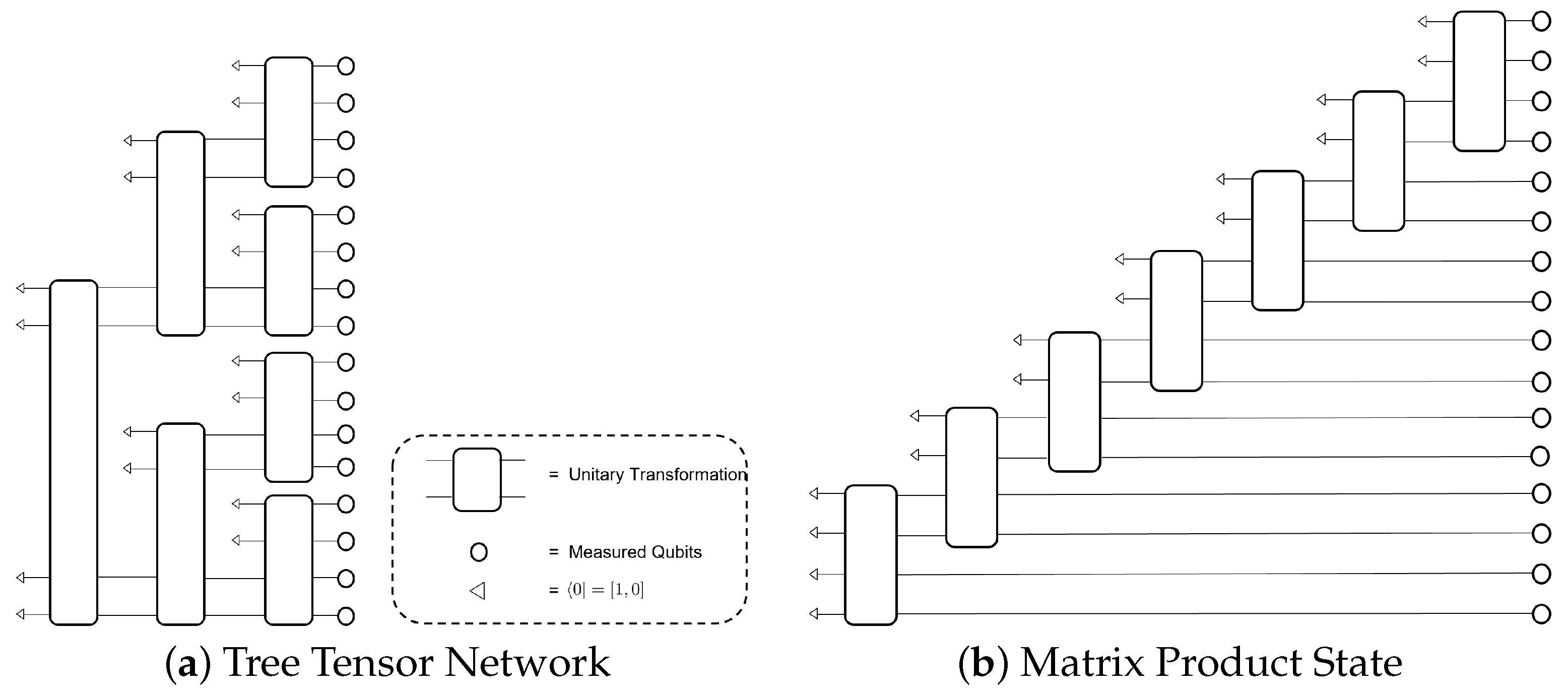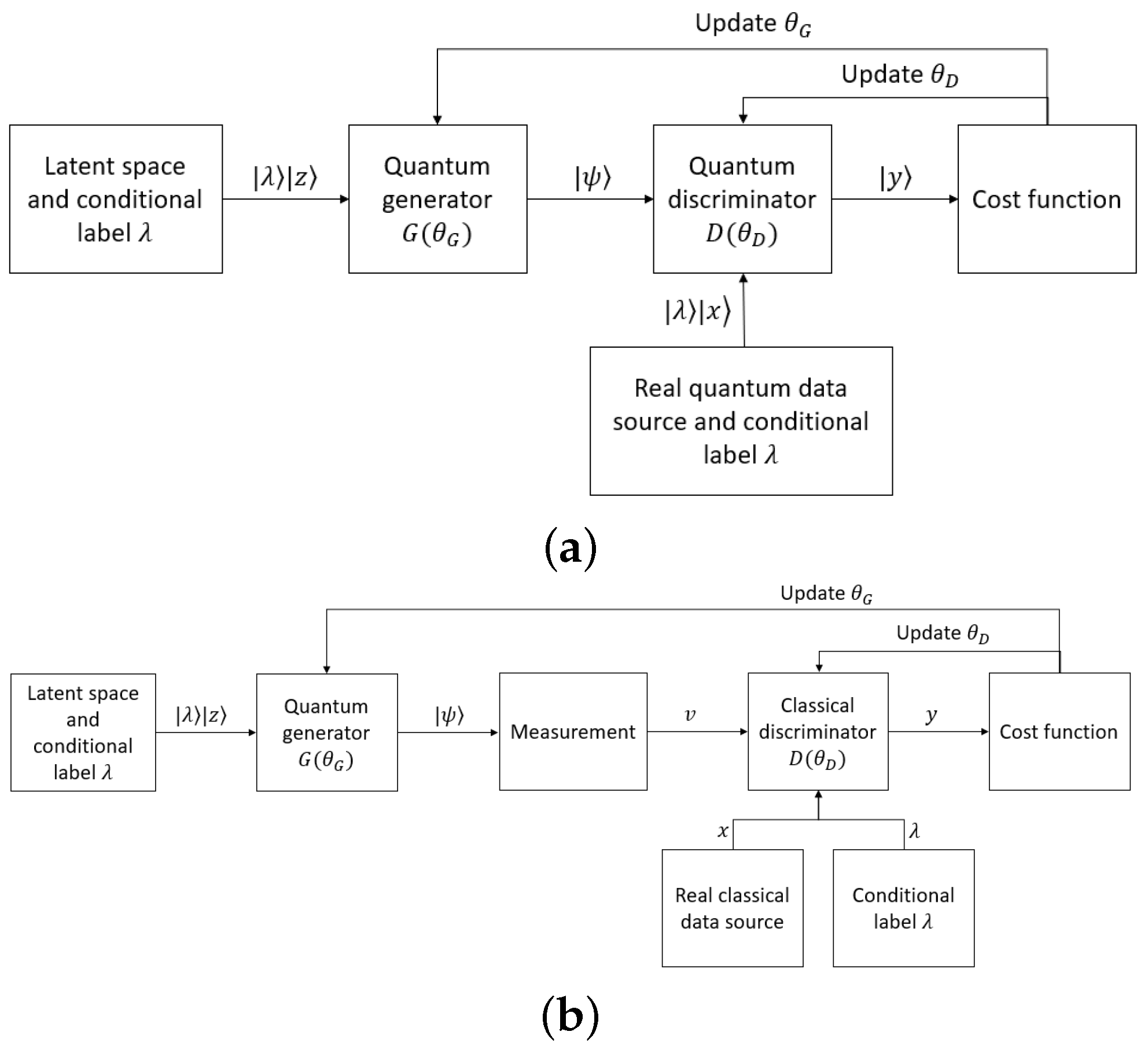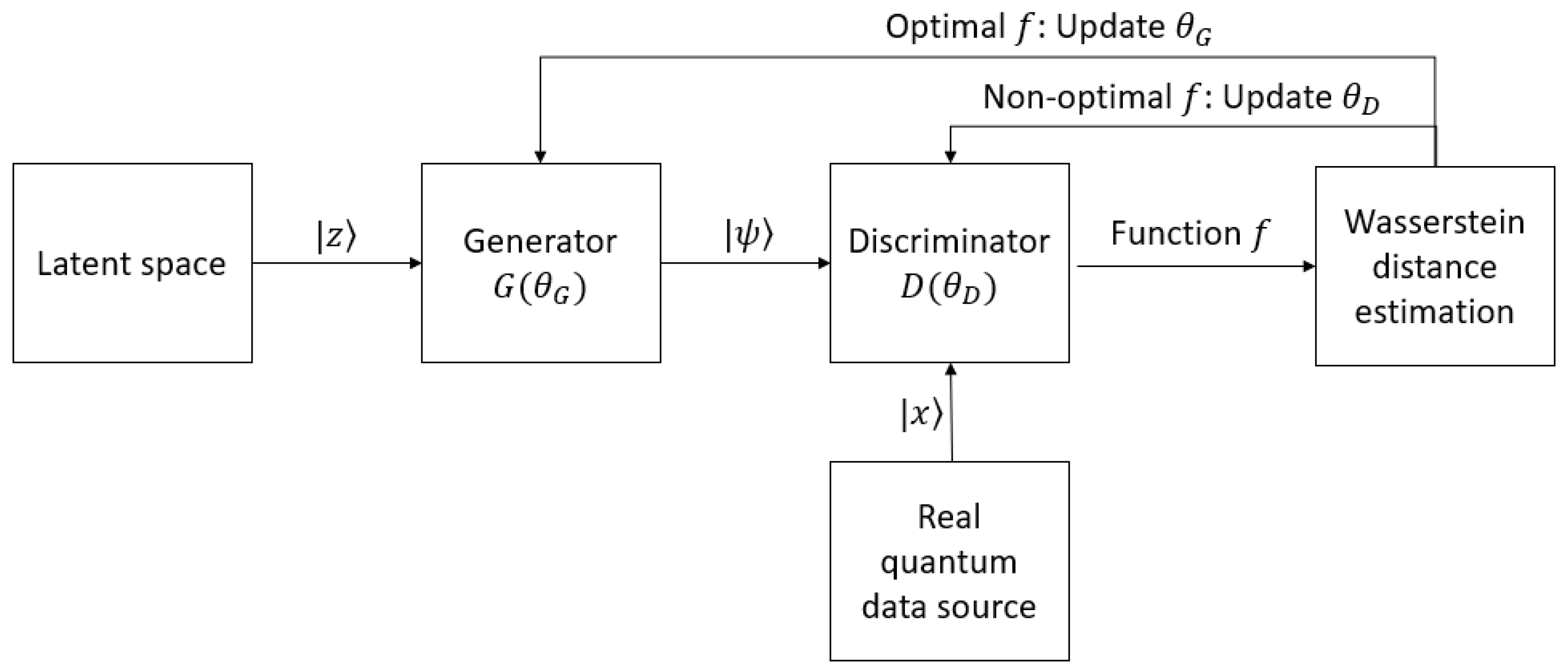A Survey of Recent Advances in Quantum Generative Adversarial Networks
Abstract
1. Introduction
2. Background
2.1. Generative Adversarial Networks (GANs)
- Total variation (TV) [61]:
- Kullback–Leibler divergence (KLD) [62]:
- Jensen–Shannon divergence (JSD) [63]:where .
- Wasserstein distance (WD) [34]:where is the set of all joint distributions whose marginals are P and Q. However, normally, the infimum is difficult to keep track of, so according to Kantorovich–Rubinstein duality, the formula can be written as
2.2. Quantum–Classical Interface
3. Structures of QuGAN
4. Optimization of QuGAN
4.1. Loss Function
4.1.1. Maximum Likelihood
4.1.2. Wasserstein Distance
4.1.3. Total Variation
4.2. Gradient Computation
4.2.1. Parameter-Shift Method
4.2.2. Linear Combination of Unitaries
4.3. Optimization and Evaluation Strategies
5. Quantum GAN Variants
5.1. Fully Quantum GANs
5.2. Hybrid Quantum–Classical GANs
5.3. Tensor-Network-Based GANs
5.4. Quantum Conditional GANs
5.5. Quantum Wasserstein GANs
5.6. Quantum Patch GANs Using Multiple Sub-Generators
5.7. Quantum GANs Using Quantum Fidelity for a Cost Function
6. Conclusions
Author Contributions
Funding
Conflicts of Interest
References
- Mitchell, T.; Buchanan, B.; DeJong, G.; Dietterich, T.; Rosenbloom, P.; Waibel, A. Machine Learning. Annu. Rev. Comput. Sci. 1990, 4, 417–433. [Google Scholar] [CrossRef]
- McCulloch, W.S.; Pitts, W. A logical calculus of the ideas immanent in nervous activity. Bull. Math. Biophys. 1943, 5, 115–133. [Google Scholar] [CrossRef]
- Rosenblatt, F. The perceptron: A probabilistic model for information storage and organization in the brain. Psychol. Rev. 1958, 65, 386–408. [Google Scholar] [CrossRef] [PubMed]
- Cortes, C.; Vapnik, V. Support-vector networks. Mach. Learn. 1995, 20, 273–297. [Google Scholar] [CrossRef]
- Hopfield, J.J. Neural networks and physical systems with emergent collective computational abilities. Proc. Natl. Acad. Sci. USA 1982, 79, 2554–2558. [Google Scholar] [CrossRef]
- LeCun, Y.; Bengio, Y.; Hinton, G. Deep Learning. Nature 2015, 521, 436–444. [Google Scholar] [CrossRef]
- Alam, M.M.; Mohiuddin, K.; Das, A.K.; Islam, M.K.; Kaonain, M.S.; Ali, M.H. A Reduced Feature Based Neural Network Approach to Classify the Category of Students. In Proceedings of the 2nd International Conference on Innovation in Artificial Intelligence, Shanghai, China, 9–12 March 2018; Association for Computing Machinery: New York, NY, USA, 2018; pp. 28–32. [Google Scholar] [CrossRef]
- Luckin, R.; Holmes, W.; Griffiths, M.; Forcier, L.B. Intelligence Unleashed: An Argument for AI in Education; Pearson Education: London, UK, 2016. [Google Scholar]
- Djambic, G.; Krajcar, M.; Bele, D. Machine learning model for early detection of higher education students that need additional attention in introductory programming courses. Int. J. Digit. Technol. Econ. 2016, 1, 1–11. [Google Scholar]
- Amatya, S.; Karkee, M.; Gongal, A.; Zhang, Q.; Whiting, M.D. Detection of cherry tree branches with full foliage in planar architecture for automated sweet-cherry harvesting. Biosyst. Eng. 2016, 146, 3–15. [Google Scholar] [CrossRef]
- Pantazi, X.E.; Moshou, D.; Bravo, C. Active learning system for weed species recognition based on hyperspectral sensing. Biosyst. Eng. 2016, 146, 193–202. [Google Scholar] [CrossRef]
- Bouri, E.; Gkillas, K.; Gupta, R.; Pierdzioch, C. Forecasting Realized Volatility of Bitcoin: The Role of the Trade War. Comput. Econ. 2021, 57, 29–53. [Google Scholar] [CrossRef]
- Lussange, J.; Lazarevich, I.; Bourgeois-Gironde, S.; Palminteri, S.; Gutkin, B. Modelling Stock Markets by Multi-agent Reinforcement Learning. Comput. Econ. 2021, 57, 113–147. [Google Scholar] [CrossRef]
- Sughasiny, M.; Rajeshwari, J. Application of Machine Learning Techniques, Big Data Analytics in Health Care Sector—A Literature Survey. In Proceedings of the 2018 2nd International Conference on I-SMAC (IoT in Social, Mobile, Analytics and Cloud) (I-SMAC), Palladam, India, 30–31 August 2018; pp. 741–749. [Google Scholar] [CrossRef]
- Hazra, A.; Kumar, S.; Gupta, A. Study and Analysis of Breast Cancer Cell Detection using Naïve Bayes, SVM and Ensemble Algorithms. Int. J. Comput. Appl. 2016, 145, 39–45. [Google Scholar] [CrossRef]
- Otoom, A.; Abdallah, E.; Kilani, Y.; Kefaye, A.; Ashour, M. Effective diagnosis and monitoring of heart disease. Int. J. Softw. Eng. Its Appl. 2015, 9, 143–156. [Google Scholar] [CrossRef]
- Goodfellow, I.; Pouget-Abadie, J.; Mirza, M.; Xu, B.; Warde-Farley, D.; Ozair, S.; Courville, A.; Bengio, Y. Generative Adversarial Nets. In Advances in Neural Information Processing Systems; Ghahramani, Z., Welling, M., Cortes, C., Lawrence, N., Weinberger, K., Eds.; Curran Associates: New York, NY, USA, 2014; Volume 27. [Google Scholar]
- Farajzadeh-Zanjani, M.; Razavi-Far, R.; Saif, M.; Palade, V. Generative Adversarial Networks: A Survey on Training, Variants, and Applications. In Generative Adversarial Learning: Architectures and Applications; Razavi-Far, R., Ruiz-Garcia, A., Palade, V., Schmidhuber, J., Eds.; Springer International Publishing: Cham, Switzerland, 2022; pp. 7–29. [Google Scholar] [CrossRef]
- Pradhyumna, P.; Mohana. A Survey of Modern Deep Learning based Generative Adversarial Networks (GANs). In Proceedings of the 2022 6th International Conference on Computing Methodologies and Communication (ICCMC), Erode, India, 29–31 March 2022; pp. 1146–1152. [Google Scholar] [CrossRef]
- Preskill, J. Quantum Computing in the NISQ era and beyond. Quantum 2018, 2, 79. [Google Scholar] [CrossRef]
- Harrow, A.W.; Montanaro, A. Quantum computational supremacy. Nature 2017, 549, 203–209. [Google Scholar] [CrossRef]
- Biamonte, J.; Wittek, P.; Pancotti, N.; Rebentrost, P.; Wiebe, N.; Lloyd, S. Quantum machine learning. Nature 2017, 549, 195–202. [Google Scholar] [CrossRef]
- Dong, D.; Chen, C.; Li, H.; Tarn, T.J. Quantum Reinforcement Learning. IEEE Trans. Syst. Man Cybern. Part B 2008, 38, 1207–1220. [Google Scholar] [CrossRef]
- Rebentrost, P.; Mohseni, M.; Lloyd, S. Quantum Support Vector Machine for Big Data Classification. Phys. Rev. Lett. 2014, 113, 130503. [Google Scholar] [CrossRef]
- Khoshaman, A.; Vinci, W.; Denis, B.; Andriyash, E.; Sadeghi, H.; Amin, M.H. Quantum variational autoencoder. Quantum Sci. Technol. 2018, 4, 14001. [Google Scholar] [CrossRef]
- Lloyd, S.; Weedbrook, C. Quantum Generative Adversarial Learning. Phys. Rev. Lett. 2018, 121, 40502. [Google Scholar] [CrossRef]
- Dallaire-Demers, P.L.; Killoran, N. Quantum generative adversarial networks. Phys. Rev. A 2018, 98, 12324. [Google Scholar] [CrossRef]
- Stein, S.A.; Baheri, B.; Chen, D.; Mao, Y.; Guan, Q.; Li, A.; Fang, B.; Xu, S. QuGAN: A Quantum State Fidelity based Generative Adversarial Network. In Proceedings of the 2021 IEEE International Conference on Quantum Computing and Engineering (QCE), Broomfield, CO, USA, 17–22 October 2021; IEEE: Piscataway, NJ, USA, 2021. [Google Scholar] [CrossRef]
- Huang, H.L.; Du, Y.; Gong, M.; Zhao, Y.; Wu, Y.; Wang, C.; Li, S.; Liang, F.; Lin, J.; Xu, Y.; et al. Experimental Quantum Generative Adversarial Networks for Image Generation. Phys. Rev. Appl. 2021, 16, 24051. [Google Scholar] [CrossRef]
- Zoufal, C.; Lucchi, A.; Woerner, S. Quantum Generative Adversarial Networks for learning and loading random distributions. NPJ Quantum Inf. 2019, 5, 103. [Google Scholar] [CrossRef]
- Li, T.; Zhang, S.; Xia, J. Quantum Generative Adversarial Network: A Survey. Comput. Mater. Contin. 2020, 64, 401–438. [Google Scholar] [CrossRef]
- Krizhevsky, A.; Sutskever, I.; Hinton, G.E. ImageNet Classification with Deep Convolutional Neural Networks. In Advances in Neural Information Processing Systems; Pereira, F., Burges, C., Bottou, L., Weinberger, K., Eds.; Curran Associates: New York, NY, USA, 2012; Volume 25. [Google Scholar]
- Mirza, M.; Osindero, S. Conditional Generative Adversarial Nets. arXiv 2014, arXiv:1411.1784. [Google Scholar]
- Arjovsky, M.; Chintala, S.; Bottou, L. Wasserstein GAN. arXiv 2017, arXiv:1701.07875. [Google Scholar]
- Berthelot, D.; Schumm, T.; Metz, L. BEGAN: Boundary Equilibrium Generative Adversarial Networks. arXiv 2017, arXiv:1703.10717. [Google Scholar]
- Brock, A.; Donahue, J.; Simonyan, K. Large Scale GAN Training for High Fidelity Natural Image Synthesis. In Proceedings of the International Conference on Learning Representations, New Orleans, LA, USA, 6–9 May 2019. [Google Scholar]
- Denton, E.; Chintala, S.; Szlam, A.; Fergus, R. Deep Generative Image Models using a Laplacian Pyramid of Adversarial Networks. arXiv 2015, arXiv:1506.05751. [Google Scholar]
- Chen, X.; Duan, Y.; Houthooft, R.; Schulman, J.; Sutskever, I.; Abbeel, P. InfoGAN: Interpretable Representation Learning by Information Maximizing Generative Adversarial Nets. arXiv 2016, arXiv:1606.03657. [Google Scholar]
- Karras, T.; Aittala, M.; Laine, S.; Härkönen, E.; Hellsten, J.; Lehtinen, J.; Aila, T. Alias-Free Generative Adversarial Networks. arXiv 2021, arXiv:2106.12423. [Google Scholar]
- Tang, X.; Wang, Z.; Luo, W.; Gao, S. Face Aging with Identity-Preserved Conditional Generative Adversarial Networks. In Proceedings of the 2018 IEEE/CVF Conference on Computer Vision and Pattern Recognition, Salt Lake City, UT, USA, 18–23 June 2018; pp. 7939–7947. [Google Scholar] [CrossRef]
- Wu, X.; Xu, K.; Hall, P. A survey of image synthesis and editing with generative adversarial networks. Tsinghua Sci. Technol. 2017, 22, 660–674. [Google Scholar] [CrossRef]
- Dolhansky, B.; Ferrer, C.C. Eye In-Painting with Exemplar Generative Adversarial Networks. arXiv 2017, arXiv:1712.03999. [Google Scholar]
- Demir, U.; Unal, G. Patch-Based Image Inpainting with Generative Adversarial Networks. arXiv 2018, arXiv:1803.07422. [Google Scholar]
- Wu, H.; Zheng, S.; Zhang, J.; Huang, K. GP-GAN: Towards Realistic High-Resolution Image Blending. arXiv 2017, arXiv:1703.07195. [Google Scholar]
- Chen, B.C.; Kae, A. Toward Realistic Image Compositing With Adversarial Learning. In Proceedings of the 2019 IEEE/CVF Conference on Computer Vision and Pattern Recognition (CVPR), Long Beach, CA, USA, 15–20 June 2019; pp. 8407–8416. [Google Scholar] [CrossRef]
- Wang, X.; Yu, K.; Wu, S.; Gu, J.; Liu, Y.; Dong, C.; Loy, C.C.; Qiao, Y.; Tang, X. ESRGAN: Enhanced Super-Resolution Generative Adversarial Networks. arXiv 2018, arXiv:1809.00219. [Google Scholar]
- Ding, Z.; Liu, X.Y.; Yin, M.; Kong, L. TGAN: Deep Tensor Generative Adversarial Nets for Large Image Generation. arXiv 2019, arXiv:1901.09953. [Google Scholar]
- Wang, C.; Xu, C.; Wang, C.; Tao, D. Perceptual Adversarial Networks for Image-to-Image Transformation. IEEE Trans. Image Process. 2018, 27, 4066–4079. [Google Scholar] [CrossRef]
- Zhu, J.Y.; Park, T.; Isola, P.; Efros, A.A. Unpaired Image-to-Image Translation using Cycle-Consistent Adversarial Networks. arXiv 2017, arXiv:1703.10593. [Google Scholar]
- Liu, M.Y.; Breuel, T.; Kautz, J. Unsupervised Image-to-Image Translation Networks. arXiv 2017, arXiv:1703.00848. [Google Scholar]
- Kong, J.; Kim, J.; Bae, J. HiFi-GAN: Generative Adversarial Networks for Efficient and High Fidelity Speech Synthesis. arXiv 2020, arXiv:2010.05646. [Google Scholar]
- Oord, A.v.d.; Dieleman, S.; Zen, H.; Simonyan, K.; Vinyals, O.; Graves, A.; Kalchbrenner, N.; Senior, A.; Kavukcuoglu, K. WaveNet: A Generative Model for Raw Audio. arXiv 2016, arXiv:1609.03499. [Google Scholar]
- Dong, H.W.; Hsiao, W.Y.; Yang, L.C.; Yang, Y.H. MuseGAN: Multi-track Sequential Generative Adversarial Networks for Symbolic Music Generation and Accompaniment. arXiv 2017, arXiv:1709.06298. [Google Scholar] [CrossRef]
- Engel, J.; Agrawal, K.K.; Chen, S.; Gulrajani, I.; Donahue, C.; Roberts, A. GANSynth: Adversarial Neural Audio Synthesis. arXiv 2019, arXiv:1902.08710. [Google Scholar]
- Uřičář, M.; Křížek, P.; Hurych, D.; Sobh, I.; Yogamani, S.; Denny, P. Yes, we GAN: Applying adversarial techniques for autonomous driving. Electron. Imaging 2019, 2019, 48-1–48-17. [Google Scholar] [CrossRef]
- Jeong, C.H.; Yi, M.Y. Correcting rainfall forecasts of a numerical weather prediction model using generative adversarial networks. J. Supercomput. 2022, 79, 1289–1317. [Google Scholar] [CrossRef]
- Besombes, C.; Pannekoucke, O.; Lapeyre, C.; Sanderson, B.; Thual, O. Producing realistic climate data with generative adversarial networks. Nonlinear Process. Geophys. 2021, 28, 347–370. [Google Scholar] [CrossRef]
- Sandfort, V.; Yan, K.; Pickhardt, P.J.; Summers, R.M. Data augmentation using generative adversarial networks (CycleGAN) to improve generalizability in CT segmentation tasks. Sci. Rep. 2019, 9, 16884. [Google Scholar] [CrossRef]
- Frid-Adar, M.; Diamant, I.; Klang, E.; Amitai, M.; Goldberger, J.; Greenspan, H. GAN-based synthetic medical image augmentation for increased CNN performance in liver lesion classification. Neurocomputing 2018, 321, 321–331. [Google Scholar] [CrossRef]
- Cheng, J.; Yang, Y.; Tang, X.; Xiong, N.; Zhang, Y.; Lei, F. Generative Adversarial Networks: A Literature Review. KSII Trans. Internet Inf. Syst. 2020, 14, 4625–4647. [Google Scholar] [CrossRef]
- Verdú, S. Total variation distance and the distribution of relative information. In Proceedings of the 2014 Information Theory and Applications Workshop (ITA), San Diego, CA, USA, 9–14 February 2014; pp. 1–3. [Google Scholar] [CrossRef]
- Joyce, J.M. Kullback–Leibler Divergence. In International Encyclopedia of Statistical Science; Lovric, M., Ed.; Springer: Berlin/Heidelberg, Germany, 2011; pp. 720–722. [Google Scholar] [CrossRef]
- Fuglede, B.; Topsoe, F. Jensen-Shannon divergence and Hilbert space embedding. In Proceedings of the International Symposium on Information Theory, Chicago, IL, USA, 27 June–2 July 2004. [Google Scholar] [CrossRef]
- Gulrajani, I.; Ahmed, F.; Arjovsky, M.; Dumoulin, V.; Courville, A. Improved Training of Wasserstein GANs. arXiv 2017, arXiv:1704.00028. [Google Scholar]
- Petzka, H.; Fischer, A.; Lukovnicov, D. On the regularization of Wasserstein GANs. arXiv 2017, arXiv:1709.08894. [Google Scholar]
- Sanjabi, M.; Ba, J.; Razaviyayn, M.; Lee, J.D. On the Convergence and Robustness of Training GANs with Regularized Optimal Transport. arXiv 2018, arXiv:1802.08249. [Google Scholar]
- Becker, E.; Pandit, P.; Rangan, S.; Fletcher, A.K. Instability and Local Minima in GAN Training with Kernel Discriminators. arXiv 2022, arXiv:2208.09938. [Google Scholar]
- Neyshabur, B.; Bhojanapalli, S.; Chakrabarti, A. Stabilizing GAN Training with Multiple Random Projections. arXiv 2017, arXiv:1705.07831. [Google Scholar]
- Ding, Z.; Jiang, S.; Zhao, J. Take a close look at mode collapse and vanishing gradient in GAN. In Proceedings of the 2022 IEEE 2nd International Conference on Electronic Technology, Communication and Information (ICETCI), Changchun, China, 27–29 May 2022; pp. 597–602. [Google Scholar] [CrossRef]
- Schuld, M. Supervised quantum machine learning models are kernel methods. arXiv 2021, arXiv:2101.11020. [Google Scholar]
- Romero, J.; Aspuru-Guzik, A. Variational quantum generators: Generative adversarial quantum machine learning for continuous distributions. arXiv 2019, arXiv:1901.00848. [Google Scholar] [CrossRef]
- Nguyen, T.; Paik, I.; Watanobe, Y.; Thang, T.C. An Evaluation of Hardware-Efficient Quantum Neural Networks for Image Data Classification. Electronics 2022, 11, 437. [Google Scholar] [CrossRef]
- Nguyen, T.; Paik, I.; Sagawa, H.; Thang, T.C. Quantum machine learning with quantum image representations. In Proceedings of the 2022 IEEE International Conference on Quantum Computing and Engineering (QCE), Broomfield, CO, USA, 18–23 September 2022; IEEE: Piscataway, NJ, USA, 2022; pp. 851–854. [Google Scholar]
- Onuoha, C.; Flaherty, J.; Nguyen, T.; Thang, T.C. Data Scanning Methods for Quantum-Classical Interface in Quanvolutional Neural Networks. In Proceedings of the 2022 IEEE International Conference on Consumer Electronics-Asia (ICCE-Asia), Las Vegas, NV, USA, 7–9 January 2022; IEEE: Piscataway, NJ, USA, 2022; pp. 1–4. [Google Scholar]
- Brandt, H.E. Positive operator valued measure in quantum information processing. Am. J. Phys. 1999, 67, 434–439. [Google Scholar] [CrossRef]
- Huggins, W.; Patil, P.; Mitchell, B.; Whaley, K.B.; Stoudenmire, E.M. Towards quantum machine learning with tensor networks. Quantum Sci. Technol. 2019, 4, 24001. [Google Scholar] [CrossRef]
- Cheng, S.; Prentice, I.C.; Huang, Y.; Jin, Y.; Guo, Y.K.; Arcucci, R. Data-driven surrogate model with latent data assimilation: Application to wildfire forecasting. J. Comput. Phys. 2022, 464, 111302. [Google Scholar] [CrossRef]
- Rudolph, M.S.; Toussaint, N.B.; Katabarwa, A.; Johri, S.; Peropadre, B.; Perdomo-Ortiz, A. Generation of High-Resolution Handwritten Digits with an Ion-Trap Quantum Computer. arXiv 2020, arXiv:2012.03924. [Google Scholar] [CrossRef]
- Shrivastava, N.; Puri, N.; Gupta, P.; Krishnamurthy, B.; Verma, S. OpticalGAN: Generative Adversarial Networks for Continuous Variable Quantum Computation. arXiv 2019, arXiv:1909.07806. [Google Scholar]
- Situ, H.; He, Z.; Wang, Y.; Li, L.; Zheng, S. Quantum generative adversarial network for generating discrete distribution. Inf. Sci. 2020, 538, 193–208. [Google Scholar] [CrossRef]
- Liu, W.; Zhang, Y.; Deng, Z.; Zhao, J.; Tong, L. A hybrid quantum-classical conditional generative adversarial network algorithm for human-centered paradigm in cloud. EURASIP J. Wirel. Commun. Netw. 2021, 2021, 37. [Google Scholar] [CrossRef]
- Zhang, K. On Mode Collapse in Generative Adversarial Networks. In Artificial Neural Networks and Machine Learning—ICANN 2021; Farkaš, I., Masulli, P., Otte, S., Wermter, S., Eds.; Springer International Publishing: Cham, Switzerland, 2021; pp. 563–574. [Google Scholar]
- Arjovsky, M.; Bottou, L. Towards Principled Methods for Training Generative Adversarial Networks. arXiv 2019, arXiv:1701.04862. [Google Scholar]
- Chakrabarti, S.; Huang, Y.; Li, T.; Feizi, S.; Wu, X. Quantum Wasserstein Generative Adversarial Networks. arXiv 2019, arXiv:1911.00111. [Google Scholar]
- Zhao, J.; Mathieu, M.; LeCun, Y. Energy-based Generative Adversarial Network. arXiv 2019, arXiv:1609.03126. [Google Scholar]
- Hu, L.; Wu, S.H.; Cai, W.; Ma, Y.; Mu, X.; Xu, Y.; Wang, H.; Song, Y.; Deng, D.L.; Zou, C.L.; et al. Quantum generative adversarial learning in a superconducting quantum circuit. Sci. Adv. 2019, 5, eaav2761. [Google Scholar] [CrossRef]
- Benedetti, M.; Grant, E.; Wossnig, L.; Severini, S. Adversarial quantum circuit learning for pure state approximation. New J. Phys. 2019, 21, 43023. [Google Scholar] [CrossRef]
- Lemaréchal, C. Cauchy and the gradient method. Doc. Math. Extra 2012, 251, 10. [Google Scholar]
- Kingma, D.P.; Ba, J. Adam: A Method for Stochastic Optimization. arXiv 2015, arXiv:1412.6980. [Google Scholar]
- Lydia, A.; Francis, S. Adagrad—An optimizer for stochastic gradient descent. Int. J. Inf. Comput. Sci 2019, 6, 566–568. [Google Scholar]
- Mitarai, K.; Negoro, M.; Kitagawa, M.; Fujii, K. Quantum circuit learning. Phys. Rev. A 2018, 98, 032309. [Google Scholar] [CrossRef]
- Schuld, M.; Bergholm, V.; Gogolin, C.; Izaac, J.; Killoran, N. Evaluating analytic gradients on quantum hardware. Phys. Rev. A 2019, 99, 032331. [Google Scholar] [CrossRef]
- Du, Y.; Hsieh, M.H.; Tao, D. Efficient Online Quantum Generative Adversarial Learning Algorithms with Applications. arXiv 2019, arXiv:1904.09602. [Google Scholar]
- Schuld, M.; Bocharov, A.; Svore, K.M.; Wiebe, N. Circuit-centric quantum classifiers. Phys. Rev. A 2020, 101, 032308. [Google Scholar] [CrossRef]
- Reddi, S.J.; Kale, S.; Kumar, S. On the Convergence of Adam and Beyond. arXiv 2019, arXiv:1904.09237. [Google Scholar]
- Kiani, B.T.; Palma, G.D.; Marvian, M.; Liu, Z.W.; Lloyd, S. Learning quantum data with the quantum earth mover’s distance. Quantum Sci. Technol. 2022, 7, 045002. [Google Scholar] [CrossRef]
- Han, Z.Y.; Wang, J.; Fan, H.; Wang, L.; Zhang, P. Unsupervised Generative Modeling Using Matrix Product States. Phys. Rev. X 2018, 8, 031012. [Google Scholar] [CrossRef]
- Guo, C.; Jie, Z.; Lu, W.; Poletti, D. Matrix product operators for sequence-to-sequence learning. Phys. Rev. E 2018, 98, 042114. [Google Scholar] [CrossRef]
- Childs, A.M.; Maslov, D.; Nam, Y.; Ross, N.J.; Su, Y. Toward the first quantum simulation with quantum speedup. Proc. Natl. Acad. Sci. USA 2018, 115, 9456–9461. [Google Scholar] [CrossRef] [PubMed]








| Year | Name | Author | Data Type | Encoding Method | Conditional | Quantum G | Quantum D | Loss Function | Gradient | Network Evaluation | Application | |
|---|---|---|---|---|---|---|---|---|---|---|---|---|
| 2018 | Quantum generative adversarial networks [27] | Dallaire-Demers et al. | Quantum | None | Yes | Yes | Yes | Total variation | Directly using a separate register | Cross entropy | Generate pure quantum state with 2 labels; Approximate quantum circuits | |
| 2019 | Quantum Generative Adversarial Networks for learning and loading random distributions [30] | Zoufal et al. | Classical | None | No | Yes | No | Log-likelihood | Parameter-shift | Relative entropy; Kolmogorov– Smirnovm statistic | Learn and load random probability distribution into quantum states; Financial derivative pricing | |
| 2019 | Quantum Wasserstein Generative Adversarial Networks [84] | Chakrabarti et al. | Quantum | None | No | Yes | Yes | Quantum Wasserstein distance with regularizer | Directly using a separate quantum circuit; Parameter-shift | State fidelity | Approximate quantum circuits | |
| 2019 | OpticalGAN: Generative Adversarial Networks for Continuous Variable Quantum Computation [79] | Shrivastava et al. | Quantum | None | No | Yes | Yes | Log-likelihood | Gate decomposition | Visualization | Generate energy eigenstates and coherent states | |
| 2019 | Quantum generative adversarial learning in a superconducting quantum circuit [86] | Hu et al. | Quantum | None | No | Yes | Yes | Total variation | By definition | State fidelity | Replicate a quantum state from a quantum channel simulator | |
| 2019 | Efficient Online Quantum Generative Adversarial Learning Algorithms with Applications [93] | Du et al. | Quantum | None | No | Yes | Yes | Total variation | Zero-order differential method; Parameter-shift | State fidelity | Entanglement test for a bipartite pure state; Approximate a pure state | |
| 2019 | Adversarial quantum circuit learning for pure state approximation [87] | Benedetti et al. | Quantum | None | No | Yes | Yes | Total variation | Parameter-shift | Trace distance | Approximate pure states | |
| 2020 | Quantum generative adversarial network for generating discrete distribution [80] | Situ et al. | Classical | None | No | Yes | No | Log likelihood | Parameter-shift | Number of valid generated samples; KLD | Generate discrete distribution such as BAS | |
| 2021 | Experimental Quantum Generative Adversarial Networks for Image Generation [29] | Quantum batch GAN | Huang et al. | Classical | Amplitude encoding | No | Yes | Yes | Log-likelihood | Parameter-shift | 2-Wasserstein distance (Fréchet distance) | Generate handwritten digit images of 0 and 1; Generate a data set of images (gray scale bar) |
| Quantum patch GAN | None | No | Visualization; Fréchet distance | |||||||||
| 2021 | QuGAN: A Quantum State Fidelity based Generative Adversarial Network [28] | Stein et al. | Classical | Angle encoding | No | Yes | Yes | Log-likelihood | Parameter-shift | Hellinger distance | Generate images of handwritten digits from the MNIST dataset | |
| 2021 | A hybrid quantum–classical conditional generative adversarial network algorithm for human-centered paradigm in cloud [81] | Liu et al. | Classical | None | Yes | Yes | No | Log-likelihood | Parameter-shift | Time complexity; Number of bits used; Visualization | Generate discrete distribution such as BAS with human orientation on the generated data | |
| 2022 | Learning quantum data with the quantum earth mover’s distance [96] | Kiani et al. | Quantum | None | No | Yes | Yes | Quantum Wasserstein distance | Directly using a linear program; Parameter-shift | State fidelity | Estimate quantum states and approximate quantum circuits | |
Disclaimer/Publisher’s Note: The statements, opinions and data contained in all publications are solely those of the individual author(s) and contributor(s) and not of MDPI and/or the editor(s). MDPI and/or the editor(s) disclaim responsibility for any injury to people or property resulting from any ideas, methods, instructions or products referred to in the content. |
© 2023 by the authors. Licensee MDPI, Basel, Switzerland. This article is an open access article distributed under the terms and conditions of the Creative Commons Attribution (CC BY) license (https://creativecommons.org/licenses/by/4.0/).
Share and Cite
Ngo, T.A.; Nguyen, T.; Thang, T.C. A Survey of Recent Advances in Quantum Generative Adversarial Networks. Electronics 2023, 12, 856. https://doi.org/10.3390/electronics12040856
Ngo TA, Nguyen T, Thang TC. A Survey of Recent Advances in Quantum Generative Adversarial Networks. Electronics. 2023; 12(4):856. https://doi.org/10.3390/electronics12040856
Chicago/Turabian StyleNgo, Tuan A., Tuyen Nguyen, and Truong Cong Thang. 2023. "A Survey of Recent Advances in Quantum Generative Adversarial Networks" Electronics 12, no. 4: 856. https://doi.org/10.3390/electronics12040856
APA StyleNgo, T. A., Nguyen, T., & Thang, T. C. (2023). A Survey of Recent Advances in Quantum Generative Adversarial Networks. Electronics, 12(4), 856. https://doi.org/10.3390/electronics12040856










